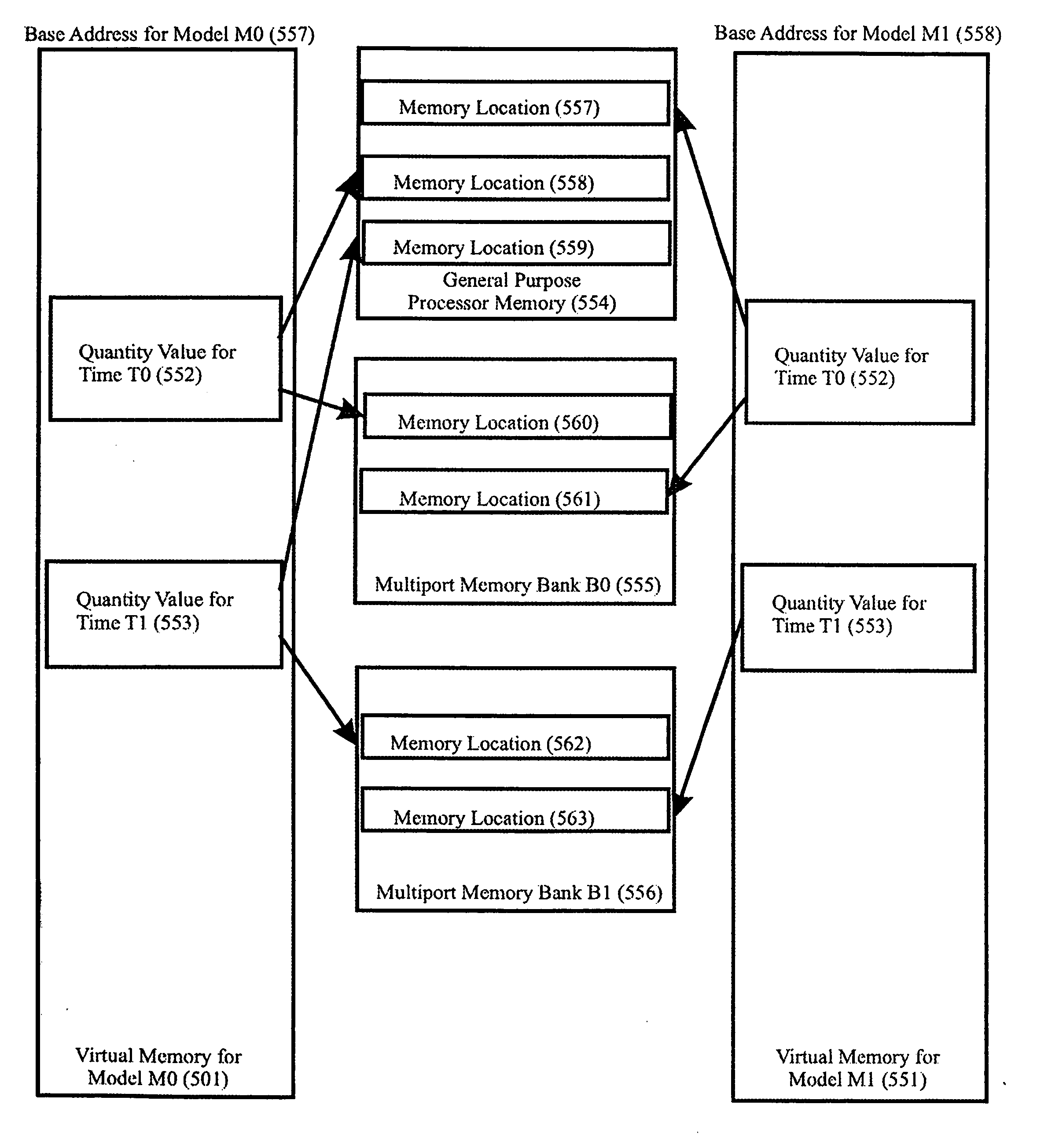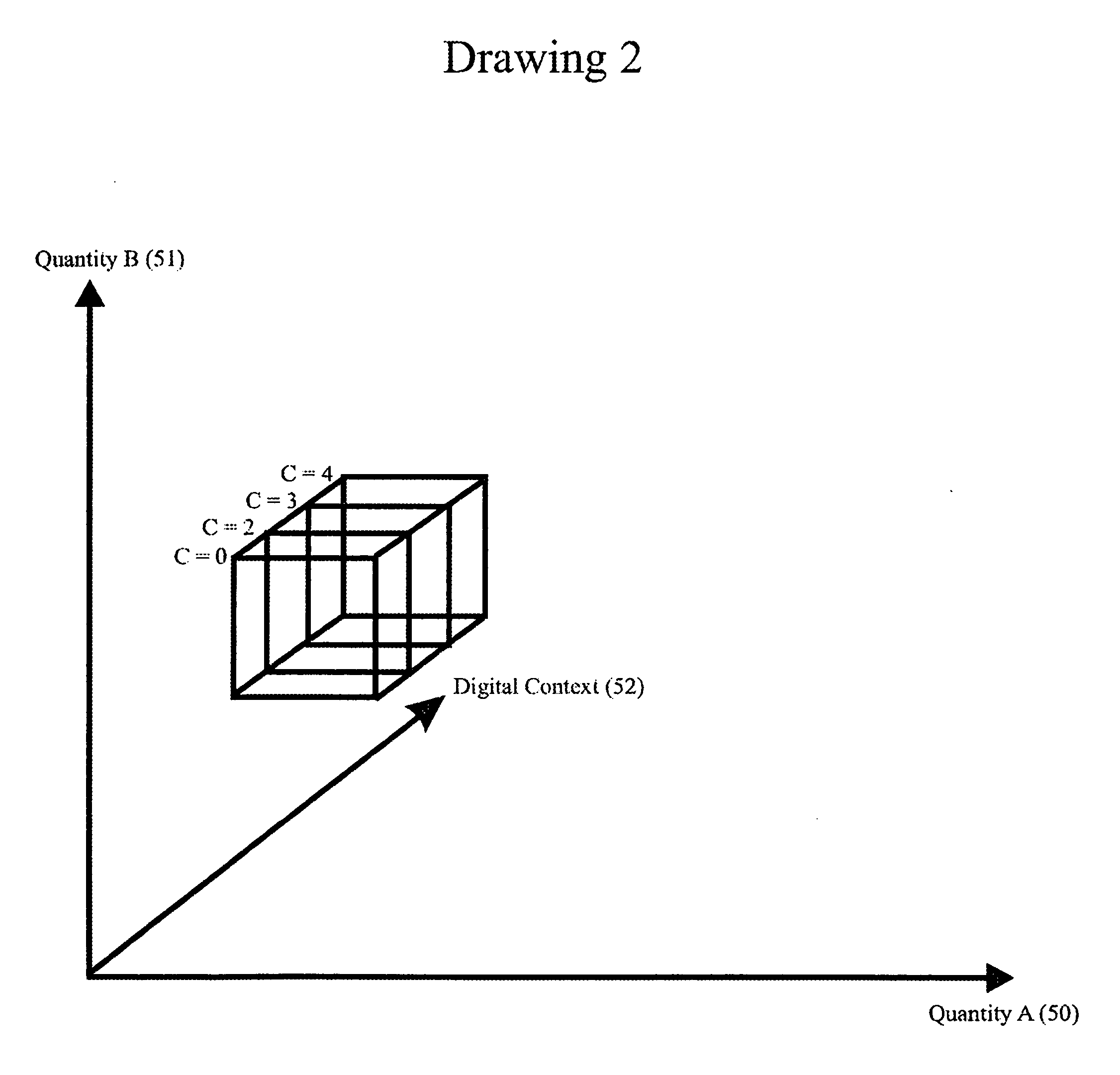Using simulation to predict the design's behavior over lengthy periods of simulated time generally requires undesirably long periods of actual or wallclock time, perhaps consuming days to simulate a mere second in the lifetime of the realized design.
Delays before simulation results are available incur an expense in time, an expense in computing resources and
delay initial design realization or modification.
Equivalently, simulation generally becomes increasingly slower as the accuracy of detail increases.
The prior art effectively addresses many aspects of modeling in either domain, however prior art does not effectively address tight integration of digital inputs, analog
time domain behavior and analog
frequency domain behavior into a common analog partition or partitions.
In the prior art, code generated to perform simulation must accommodate the worst case resolution context and thus is less efficient than if code was generated for the actual number of active inputs to the resolution functions.
Unfortunately in the prior art, code implementing the resolution is commonly fixed prior to elaboration or at best prior to simulation.
In the average case, this flexibility slows simulation.
Systems comprising non-linear components are computationally more complex to simulate and thus slower than
linear system simulations.
If transformed sides of a
characteristic equation were required to match exactly at the end of each successful analog
solver cycle, many simulations would fail to converge and thus terminate after reaching an iteration or
time limit.
However in prior art, compilation completes before simulation begins and thus cannot benefit from any
contextual information know only during and after simulation, thus decreasing simulation performance.
If an analog
solver is split across more than one processor (multiprocessor), the lack of
contextual information encountered when practicing prior art has an even more severe performance
impact than with a single processor.
In a
sparse matrix implementation, it is difficult or impossible to predict and schedule
reference patterns so as to effectively schedule multiple processors or functional units to execution distinct portions of the same analog solver, to avoid cache to cache conflicts or to avoid locking of data structures (and thus performance degradation due to contention).
The parallelism available inside of such devices results in substantial speedups relative sequential simulation execution through the execution pipeline of a single processor or a modest number of processors within a multiprocessor.
Prior art does not teach any efficient means for utilizing the parallelism of electronically re-configurable logic devices for the simulation of analog, mixed-signal or full-wave abstraction levels.
From the standpoint of simulation use, this device substantially lacks accuracy,
noise-
immunity,
dynamic range, capacity and flexibility required for effective simulation of analog, mixed-signal or full-wave abstractions.
Large designs, especially when modeled at analog, mixed-signal or full-wave levels of abstraction may readily become too large to fit on a single electronically re-configurable logic device or FPGA, requiring partitioning of a single design across more than one such device to efficiently perform simulation.
As a result, pins on and off the device become an increasingly limiting resource.
However, off-
chip interconnects are still more power-intensive than on-
chip interconnects, resulting in an increasing incentive to reduce the number of off-
chip interconnects required to fulfill a given functionality.
Inefficient use of scarce interconnect resources, as prior art does, results in less effective use of electronically re-configurable logic devices, requiring more devices to partition a design.
Dividing a design into additional devices increases cost and slows simulation.
Although the pins of electronically re-configurable logic devices are becoming a
limiting factor to effective design size and cost, it is also difficult to implement many
arithmetic operators with both high precision and
wide dynamic range on a given electronically re-configurable logic array.
If the configured device in operation operates outside this specification, overflow, underflow or loss of precision may lead deviations between behavior of a design model and a realized design, ultimately having the potential to cause design failure.
Even serial implementations of
floating point operators are significantly larger and more complex than integer representations, putting FPGA logic at a premium.
Numerical precision is much more difficult to formulate than for integer operations since precision changes as
floating point values deviate from a central value, typically 1.0.
Given finite implementation resources, over-design must come at the expense of both decreased functionality and increased
power consumption.
Over-design throughout a design generally results in a significant decrease to both the design's user functionality and power, yet it only delays the potential for failure due to overflow, underflow or loss of precision.
For business reasons, owners of this
intellectual property want to export models representing the behavior of these components while restricting the level of implementation or realization detail exposed.
Such models must be decrypted before simulation begins, leading to the potential for disassembly of the model's
assembly code representation and thus compromise of the owner's
intellectual property.
Inserting actual devices requires an expensive
test set in order to operate the isolated device with a suitable speed, timing, power and cooling.
Prior art capable of introducing an actual device into a simulation do not address simulation at the analog, mixed-signal or full-wave abstraction levels.
Prior art implies substantial time and therefore cost resulting from the need to maintain the chip's specific
operating environment.
These are important disadvantages to wide-spread use.
Development of accurate analog, mixed-signal, and full-wave models of a design or design component is
time consuming and error-prone.
In the prior art, such models tend to evolve manually, with ever-increasing complexity attempting to adapt existing models to new requirements or operating conditions.
Even the evolution of such models requires specialized designer skill, a skill which is often in short supply.
The prior art offers techniques for manually fitting a model around characterization of operating specifications, however both the gathering of such specifications and the effective fitting of data to achieve a new model is a slow, manual process in the prior art.
The cost and time expenditure implicit in such a manual process are a significant
disadvantage of the prior art.
Comparison of analog, mixed-signal or full-wave models via exhaustive simulation is both
time consuming and ultimately fragile.
Since it is not possible to simulate all operating
modes in a bounded time, the risk of missing a key difference in the behavior of reference and comparison model must remain.
Even the time required to conduct enough simulation to approach a given confidence level increases beyond practical limits as the complexity of devices being compared increases.
Textual comparisons of reference and comparison models are especially fragile.
Therefore prior art based on textual comparison, such as the common available textual differencing utilities are of little practical value in the problem of analog, mixed-signal or full-wave model comparison.
 Login to View More
Login to View More  Login to View More
Login to View More 


